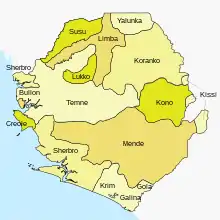Volksgruppen und Sprachen in Sierra Leone
Sierra Leone ist ein Vielvölkerstaat in dem zahlreiche Ethnien heimisch sind. 2015 hatte Sierra Leone knapp 7,1 Millionen Einwohner, die offiziell 15[1] Volksgruppen und ebenso vielen Sprachen angehören. Ethnologue kennt hingegen 25 lebende Sprachen in Sierra Leone, wovon zwei vom Aussterben bedroht sind.[2]

Die Temne und Mende stellen mit jeweils mehr als zwei Millionen Menschen die größten Volksgruppen in Sierra Leone dar. Ihre Sprachen werden am häufigsten als Muttersprache gesprochen, gefolgt von Krio.[1]
Amtssprache in Sierra Leone ist Englisch, Hauptverkehrssprache (Lingua Franca) ist Krio.
Volksgruppen und Muttersprachen
Anmerkung: Sortiert nach Anteil im Jahr 2015.
| Volksgruppe | Anteil in % (1963)[3] | Anteil in % (2003/04)[4] | Anteil in % (2013)[5] | Absolut (2015)[1] | Anteil in % (2015)[1] | Sprache | Absolut (2015)[1] | Anteil in % (2015)[1] |
|---|---|---|---|---|---|---|---|---|
| Mende | 30,9 | 37,45 | 33,2 | 2.258.232 | 32,2 | Mende | 2.065.349 | 29,7 |
| Temne | 29,8 | 23,83 | 35,5 | 2.220.211 | 31,7 | Temne | 1.851.300 | 26,6 |
| Limba | 9,86 | 6,4 | 592.190 | 8,5 | Limba | 380.060 | 5,5 | |
| Kono | 4,4 | 363.051 | 5,2 | Kono | 306.824 | 4,4 | ||
| Koranko | 2,8 | 313.384 | 4,4 | Koranko | 277.356 | 4,0 | ||
| Fullah | 3,4 | 266.581 | 3,5 | Fullah | 173.003 | 2,5 | ||
| Susu | 203.779 | 2,9 | Susu | 155.175 | 2,2 | |||
| Kissi | 2,98 | 175.843 | 2,5 | Kissi | 154.341 | 2,2 | ||
| Loko | 2,53 | 2,9 | 165.692 | 2,4 | Loko | 91.668 | 1,3 | |
| Madingo | 2,26 | 2,4 | 160.080 | 2,2 | Madingo | 88.650 | 1,3 | |
| Sherbro (Bullom) | 1,20 | 2,6 | 134.606 | 1,9 | Sherbro | 81.304 | 1,2 | |
| Krio (Kreolen) | 5,62 | 1,2 | 94.593 | 1,3 | Krio | 1.265.295 | 18,2 | |
| Yalunka | 51.781 | 0,7 | Yalunka | 44.935 | 0,6 | |||
| Krim | 15.729 | 0,2 | Krim | 1.669 | 0,0 | |||
| Vai | 0,06 | 1.205 | 0,0 | Vai | 1.043 | 0,0 |
Ethnologue nennt zudem folgende Sprachen für Sierra Leone, woraus sich auch ein Vorkommen der jeweiligen Volksgruppen im Land ableiten lässt: Maninkakan (Malinke), N’Ko, Bassa (Bassa), Bullom So (Bullom-Sherbro), Gola (Gola), Klao, Pular (Fullah) und Bom. Zu den zuletzt zugewanderten Volksgruppen zählen die wirtschaftlich einflussreichen Libanesen.[6] Die Kru und Bassa sind aus Liberia zugewandert. Bei den Maroons handelt es sich um befreite Sklaven.
Literatur
- C. Magbaily Fyle: Unity in Diversity: Ethnicity and National Consciousness in Sierra Leone. National Consultative Conference – Building a United and Cohesive Nation, 2013; democracy.gov.sl (PDF; 140 kB)
- Suzanne LeVert: Cultures of the World, Sierra Leone. Marshall Cavendish Benchmark, New York 2006, ISBN 978-0-7614-2334-8 (books.google.com.na)
Weblinks
- Sierra Leone. Ethnologue.com (englisch)
Einzelnachweise
- Sierra Leone 2015 Population and Housing Census national analytical report. (PDF; 12 MB) Statistics Sierra Leone, Oktober 2017, S. 89 ff.
- Sierra Leone. Ethnologue.com; abgerufen am 7. März 2019.
- Population And Housing Census Sierra Leone – The Analytic Report. (PDF; 5,4 MB) Central Statistics Office, 1995, S. 15.
- Sierra Leone Integrated Household Survey (SLIHS) 2003/04. Government of Sierra Leone, November 2007. (statistics.sl (PDF) (Seite nicht mehr abrufbar, Suche in Webarchiven) Info: Der Link wurde automatisch als defekt markiert. Bitte prüfe den Link gemäß Anleitung und entferne dann diesen Hinweis. )
- Sierra Leone. In: The World Factbook. CIA, 2013 (cia.gov)
- Mohammed B. Sillah: The Lebanese Immigrants in Sierra Leone: A Market Dominant-Minority and Revisiting the Constitutional Statute for Naturalization and Citizenship. In: American International Journal of Social Science, Vol. 5, No. 4, August 2016; aijssnet.com (PDF)